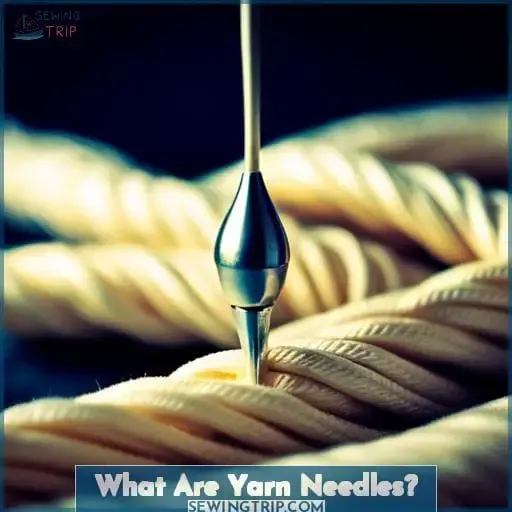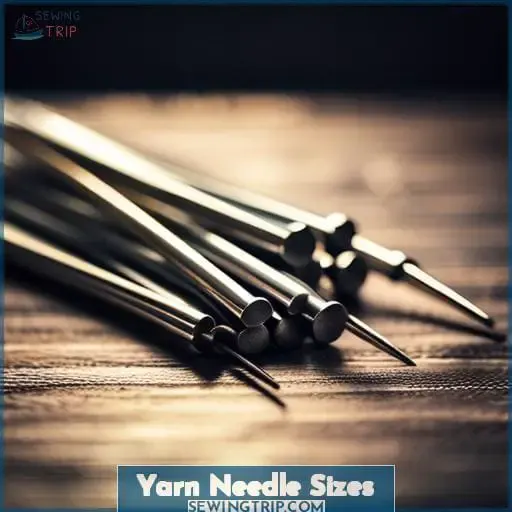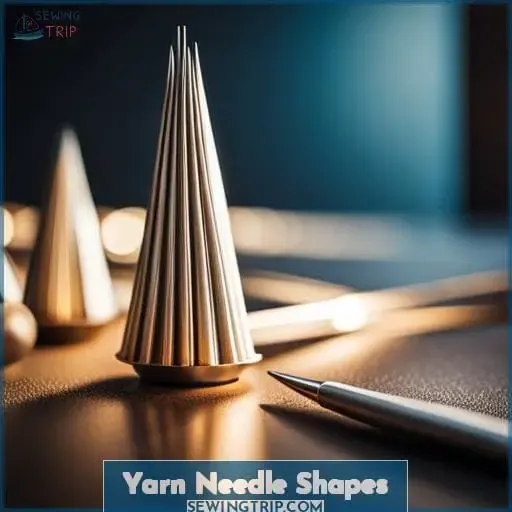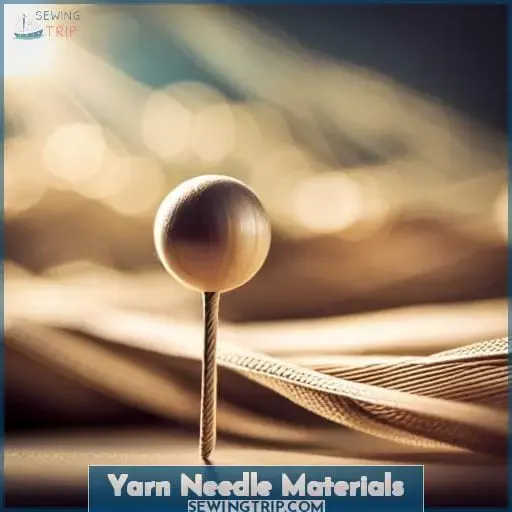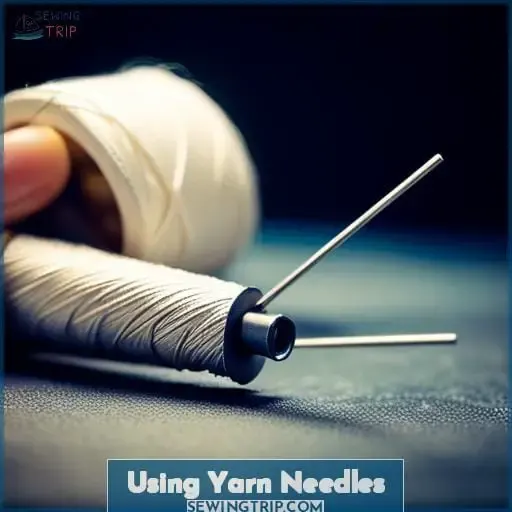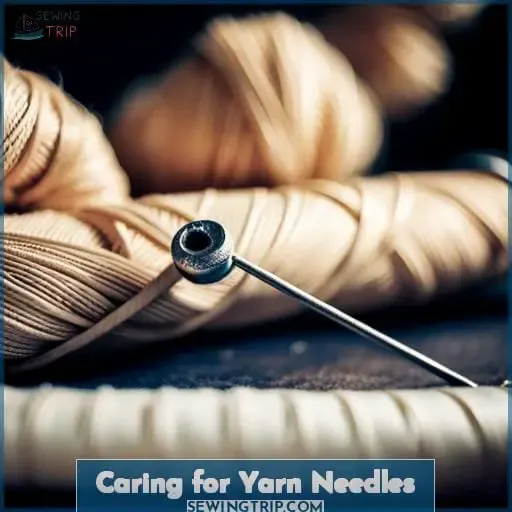This site is supported by our readers. We may earn a commission, at no cost to you, if you purchase through links.
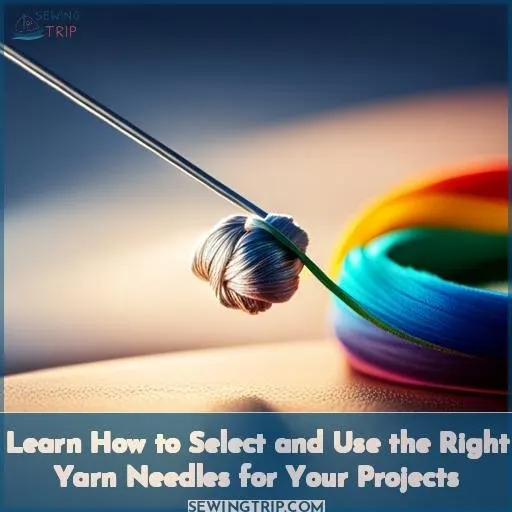 All knitters and crocheters have experienced the frustration of finishing a project only to find loose ends poking out. Taming those unwieldy tails requires a specialized tool – the humble yet handy yarn needle.
All knitters and crocheters have experienced the frustration of finishing a project only to find loose ends poking out. Taming those unwieldy tails requires a specialized tool – the humble yet handy yarn needle.
This versatile implement, available in a variety of sizes and shapes, is an essential item in every crafter’s kit.
Whether you need to weave ends into seams or sew up holes, the right yarn needle makes light work of tedious tasks. Approach your next project with confidence by arming yourself with the perfect needles for the job.
With a quality set of yarn needles by your side, you’ll give your handmade creations a polished finish. The right yarn needle makes quick work of weaving in ends and closing up holes. Having a variety on hand allows you to select the perfect size and shape for each task.
Equip your crafter’s kit with this essential tool to add finesse to your finished knits and crochet.
Table Of Contents
Key Takeaways
- Yarn needles come in various types like tapestry, hand sewing, fine, bent, double ended based on the yarn weight, stitches, and project needs.
- Matching the yarn needle size to the yarn weight is important – large needles for bulky yarns, small for lace weight.
- Yarn needle points can be sharp, blunt, straight, bent or curved to serve different purposes.
- Proper techniques include threading the eye, pulling through stitches smoothly, using the right tension, and selecting the appropriate needle size and shape.
What Are Yarn Needles?
When your latest craft project is underway, you will want the right yarn needles for the job. Whether you need a blunt tapestry needle with a large eye to weave through canvas or a sharp hand sewing needle to stitch sturdy seams in heavyweight fabric, selecting the proper needle is key.
Having an assortment of needles for different materials and techniques will make your creative process easier and achieve optimal final results.
Tapestry Needles
Fine points easily pierce fabric.
Large eyes accommodate thicker threads.
Blunt ends won’t damage fabric.
Tapestry needles are essential for detailed needlework like embroidery, needlepoint, and canvas work. Their specialized design allows crafters to create intricate designs without damaging delicate fabrics and threads.
Hand Sewing Needles
You can pierce tough fabrics easily with Singer’s heavy duty hand needles. Their high carbon steel construction and sizes 14-18 are ideal for heavyweight fabrics like denim, canvas, leather, and vinyl.
Sold in convenient packs, these needles help you complete all your heavy duty hand sewing projects with ease.
| Sharp Points | Blunt Points |
|---|---|
| Piercing | Protecting |
| Precise | Safe |
| Tapestry | Embroidery |
| Fine Stitches | Coarse Fabrics |
Whether you need sharp points for precise stitches or blunt ends to safely handle delicate fabrics, specialized needles like Singer’s heavy duty options make your hand sewing and crafting projects easier and more professional looking.
Yarn Needle Sizes
When choosing yarn needles, you’ll want to match the size to your thread and project.
For thick yarn, use large, blunt plastic needles with a big eye to easily thread bulky fibers.
With fine threads or beads, small steel needles around sizes 10-15 with sharp points can pierce fabric and weave through tiny holes.
Medium sizes fit well for most average weight yarns. Check the needle’s eye accommodates your yarn’s thickness. Shorter bent needles are great for sewing seams or reaching tight spaces like sock heels or amigurumi toy parts.
Having an assortment of needle sizes and materials on hand ensures you can find the right one for each handcraft technique.
Yarn Needle Shapes
When selecting a yarn needle for your project, consider the shape. Straight needles easily pierce fabric and slide through stitches, while bent-tip needles allow you to seam and reach into tight spaces.
Straight
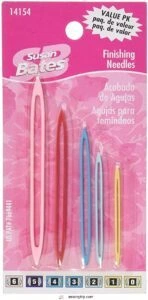 View On Amazon
View On Amazon Straight needles are ideal for easing regular stitches and rows in flat pieces. Their simple shape suits most handcrafts.
- Weave through straight rows
- Good for flat panels
- Easiest threading
- Hard to reach curved areas
- Can’t turn tight corners
- Limited versatility
Sharp points pierce fabric when starting knots or joining yarns. Long, thin straight needles hide within stitch contours when fiber felting, spinning, or dyeing. Points precisely place threaded stitches and excel at detailed crafts. However, bent and curved needles better suit more versatile handcrafting.
Bent
Hooked needles deftly maneuver tight corners. Weave bent steel tips through intricate crochet motifs. Reach into cylindrical amigurumi forms to stitch rounds in place. Secure beads in sequence along contours with precise piercing.
Curved needles craft three-dimensional shapes and embellished designs. Their agility creates dimension in your work.
Yarn Needle Materials
You’ll want to consider the pros and cons of various yarn needle materials like steel, plastic, and wood. Steel needles are known for their durability and ability to glide smoothly through yarn, though the metal can snag fibers if you aren’t careful.
Plastic needles avoid snags but may distort over time and frustrate crafters with their tendency to bend and dull. Wooden needles can feel softer on your hands but have a tendency to split and crack with prolonged use.
Steel
Steel’s durability makes them your go-to for projects that’ll see some wear and tear. These steel beauties effortlessly pierce fabric and glide through stitches. Their sturdy metal construction laughs in the face of snags and bends.
Attaching charms, threading beads, decorative edging, stitch markers, needle felting – steel needles tackle it all with ease. Whether you’re looking for large tapestry needles, sturdy yarn needles, or a variety of sizes for specialty techniques, you’ll find steel’s strength and precision perfect for the job.
Plastic
You’re prizing plastic’s price point, but beware its bend – it’ll distort your careful craft.
- Distressing deformation
- Maddening misshaping
- Excruciating errors
- Nightmarish needles
- Raging rigidity
Plastic’s defects dishearten devoted crafters. Seek sturdier steel – it sews sublime stitches that shine.
Wood
Though wooden needles are wonderfully warm, their fibers eventually fray.
| Pros | Cons |
|---|---|
| organic feel | prone to splintering |
| grippy texture | absorbs oils and dirt |
| lightweight | not as smooth |
| warm to the touch | can warp over time |
| smooth finish optional | not ideal for lace projects |
Crochet crowns for lion and lamb amigurumi are darling, but wood risks snagging their knitted coats. For finer pieces, try coated wood or plastic – their precision is perfect for intricate loops.
Using Yarn Needles
Grabbing your yarn needle is crucial when finishing your knit or crochet project. Whether you need to weave in ends to conceal all those starting and stopping points or want to stitch seams between pieces, a good quality needle up to the task makes all the difference.
Carefully threading your yarn through the eye, you’ll want to weave ends inside existing stitches, changing direction often to secure them. For seams, options like the whip or ladder stitch allow joining with minimal disruption to the pattern.
With the right technique, you can finesse those final touches for a polished look ready to show off.
Weaving in Ends
You’ll conceal ends inside stitches when you weave them in with the needle. Switch up needle direction as you gently pull the yarn through existing knit or crochet work. Avoid damaging stitches or showing through finished pieces. Tapestry needles come in different sizes and shapes for finishing sweaters, hats, amigurumi, and more.
Sewing Seams
When sewing seams, whipstitch pieces together or use a ladder stitch for a seamless join on your knitting. Pull the stitches tight and thread multiple needles to quickly sew long seams. For smooth finished knits, tension the stitches evenly as you sew.
Consider beeswax or fine oil to lubricate the needle when threading thick yarns through small eyes. Test different stitches and needles for the most invisible seams on your crochet and knitting projects.
Caring for Yarn Needles
When finishing your latest knit or crochet project, proper yarn needle care ensures quality results next time. Wipe needles clean after each use and store them properly in a case or book to prevent bending.
Lightly oiling needles occasionally keeps the needles moving smoothly through stitches.
Cleaning
You’d honestly expect your yarn needles to survive Armageddon, yet here we are gently wiping them clean after each use. Regularly polish your tools to avoid rusting by gently wiping with a soft cloth, taking care to be smooth and gentle.
Store needles in cases to prevent scratches. For stuck-on fibers, carefully scrape with a dull knife. Apply mineral oil occasionally to prevent corrosion. Keeping them pristine makes threading the eye and stitching your amigurumi easier.
The needles will thank you by gliding smoothly through even the finest yarn to fashion bunnies, blankets, and more.
Storage
- Store them in needle books sorted by size. This keeps sizes together and makes it easy to find the size you need.
- Stand them upright in vases like flowers. It makes for cute decor and keeps them from getting jumbled.
- Mount them on magnetic strips for easy grabbing. The strips can go on the wall for quick access.
- Roll them in soft cloth inside travel tins. The cloth protects them and the tins keep sets together on the go.
Keeping your needles tidy helps you find the right size quickly. Organized needles are less likely to snag your knitting bag.
Frequently Asked Questions (FAQs)
How do I thread the eye of a yarn needle?
When threading that tiny eye, don’t let frustration take hold. Simply cut your yarn at an angle, dip the tip in water to stiffen, and let a needle’s sharp point pierce the abyss. A steady hand and meditation will guide you through this needle’s journey in the blink of an eye.
What are some tips for weaving in ends with a yarn needle?
Dip and weave through stitches, frequently changing the needle’s direction. Split the ply to thin it out, following the yarn’s contours. Conceal inside existing stitches for invisible joins. Vary the length and angle, avoiding knots.
How do I join new yarn when my yarn runs out?
Don’t knot or splice new yarn; weave in ends later. Overlap 10 inches of new and old yarn. Knit a few stitches with both held together. Then drop old yarn and continue knitting with only the new yarn for a smooth, nearly invisible join.
What is the best way to start and end yarn when knitting or crocheting?
Here are two tips for smoothly starting and ending yarn when knitting or crocheting. First, thread a yarn needle and weave at least 4 inches into existing stitches to hide ends. Use a pinch of tension while weaving to blend in. Avoid unsightly knots by tying new and old yarn together using a secure square knot before knitting onward.
Can I use yarn needles for embroidery and cross stitch?
Certainly! Yarn needles are versatile tools perfect for embroidery and cross stitch. Their sharp tips easily pierce fabric, while large eyes smoothly slide floss and thread. Durable steel construction will not bend or break when pulling through stitches.
Whether stitching delicate designs or sewing hearty pieces, yarn needles are well-suited for any fiber art project.
Conclusion
You’ve got this, crafter! With the right yarn needle for your project, like a trusted friend, you’ll tackle your handcrafting goals together. Whether weaving ends, joining seams, or starting new yarns, select your yarn needle wisely.
Let it enable your creativity, not hinder it. A needle suited to your yarn and task, with a sharp point and smooth eye, becomes an extension of your capable hands. Master proper needle use for flawless finishes. Then display your handmade heirlooms with pride, confident in your mastery of yarn needle skills.

